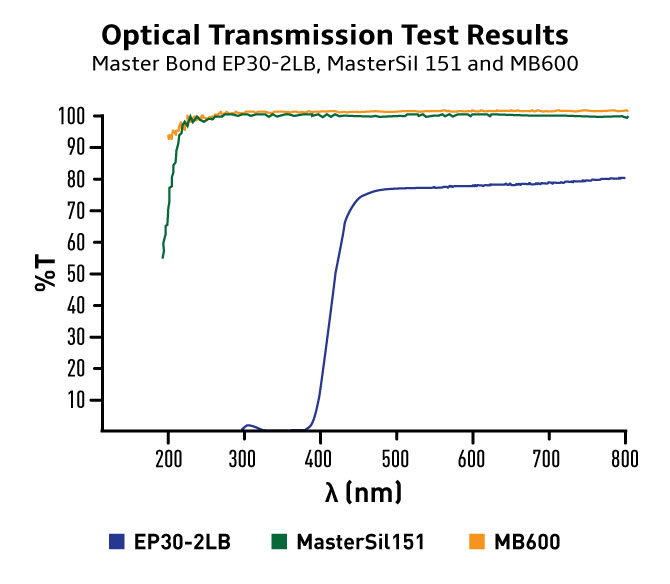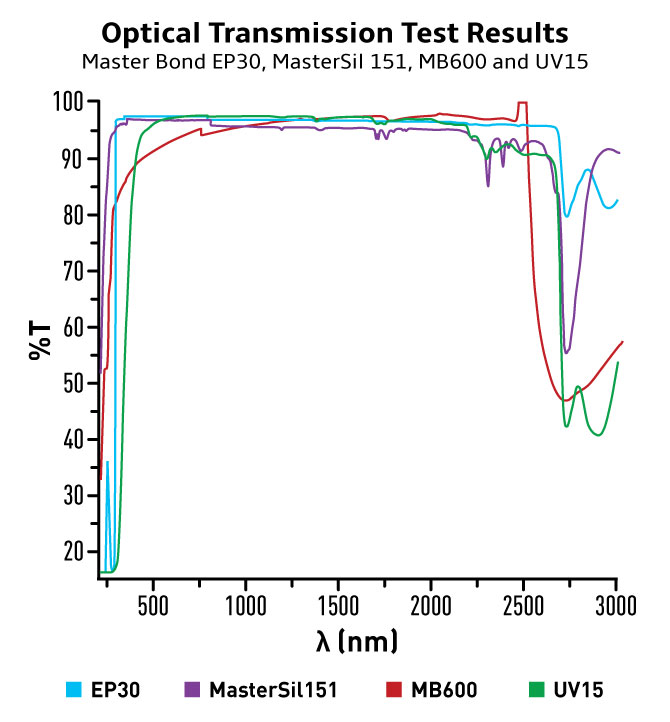Optical transmission, the ability for light to be channeled through a material, is particularly important for fiber optic, opto-electronic and photonic applications. Superior transparency is an essential characteristic of an optical adhesive. Optical transmission is measured from 0 to 100% on a wavelength scale of approximately 200 to 3100 nanometers (nm). Another common and interchangeable measurement of wavelength is microns, μm. Ultra violet (UV) light typically falls in the 200-400 nm range. From approximately 400-700 nm (0.4-0.7 microns), there is "visible light". After that, from about 700nm to 1 mm, you have "infrared light", (IR) which can be further broken down into near infrared (0.75-2 μm), middle infrared (2-15 μm), and far infrared 15 μm to 1mm.
Most optically clear epoxies, polysulfides, and silicones exhibit excellent light transmission across the visible, and near IR ranges, with some specialty systems providing a high transmission in the UV and in the middle IR wavelength ranges.
There are numerous applications, wherein optical transmission is required. For example, a manufacturer of IR lasers would inquire about epoxies with a transmission capability in the wavelengths between 800 and 1500 nm range. Other applications include LED lights, display panels, and optical lens coupling, which might need optically clear adhesives, sealants, and encapsulants which transmit in the visible range. There are rare cases where a manufacturer of night vision goggles may need to block UV light.
To help engineers meet specific requirements for a wide variety of optical related applications, Master Bond has tested several epoxies through independent laboratories, as well as various research organizations at universities over the years. To measure the optical transmission of an epoxy, a cured film, usually about 0.002 to 0.004 inches (2 to 4 mils) in thickness, is prepared. This specimen would then be put through a UV-Vis and IR spectrophotometers to obtain the transmission curve.
Some of the products that Master Bond sent out for independent testing include EP30, EP30-2LB, MasterSil 151, MB600, and UV15. The results and conclusions are reported in the table* and graphs below.
| Product | UV Transmission (200-400 nm) |
Visible Light Transmission
(400 – 700 nm) |
IR Transmission
(700 nm-2000 nm) |
| EP30 | 350-400 nm: > 95% | >95% | >95% |
| MasterSil 151 | 200 -225 nm:<80% 225-400 nm: >90% |
>95% | >95% |
| MB600 | 200 -250 nm:<90% 250-400 nm: >95% |
>90% | >90% |
| UV15 | Absorbs UV light | >95% | >95% |
On Graph 1, we show the results of EP30-2LB, MasterSil 151 and MB600. EP30-2LB is a two component room temperature curing, optically clear epoxy. Test results showed that this epoxy transmits well from 450 to 900 nm and above. However, it has the unique to block UV light completely from 200 to 400 nm, and is widely used in applications where UV blocking is critical, yet transmission is needed in the visible wavelengths.
MasterSil 151 is noteworthy for its low index of refraction and its ability to transmit light very well from 225-2500 nanometers. It is a silicone compound that combines remarkable flexibility, high temperature resistance, superb electrical insulation and outstanding optical clarity. These properties enable it to be used for coating, sealing, and potting applications involving sensitive optical and opto-electronic type applications.
MB600 retains its optical clarity after curing and has very special light transmission properties, particularly in the UV range of 200-350 nm. It is a one part, aqueous based sodium silicate system widely used for coating applications requiring excessively high temperature resistance, since it is serviceable up to 1,500°F.

In Graph 2, we show results of wavelengths ranging from 400 to 3000 nm for these adhesives: EP30, MasterSil 151, MB600 and UV15. EP30 shows very good optical clarity with superior light transmission when compared to many other epoxies. It is a low viscosity, two part epoxy, widely used for bonding, coating, sealing and casting applications. UV15 is a UV curable epoxy based system, which provides excellent optical clarity and light transmission properties.
To meet ever increasing industrial demands, Master Bond continues to develop advanced systems with unparalleled optical transmittance.

For more information on Master Bond epoxy adhesives for optical, opto-electric and other related applications, please contact our technical advisors.
*Disclaimer: Please note that the percentages in the table below are estimates based on the chart produced by the spectrometer.
